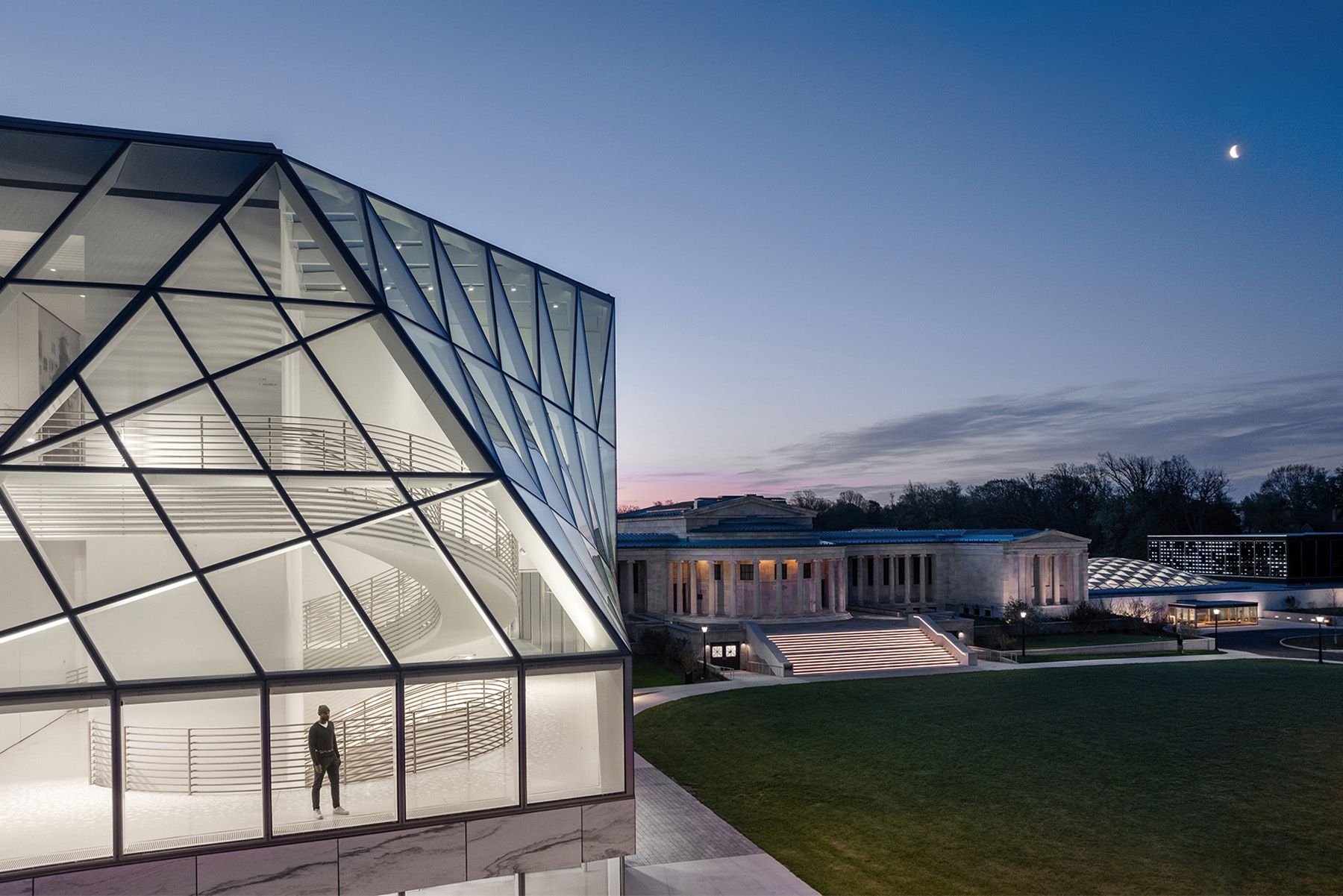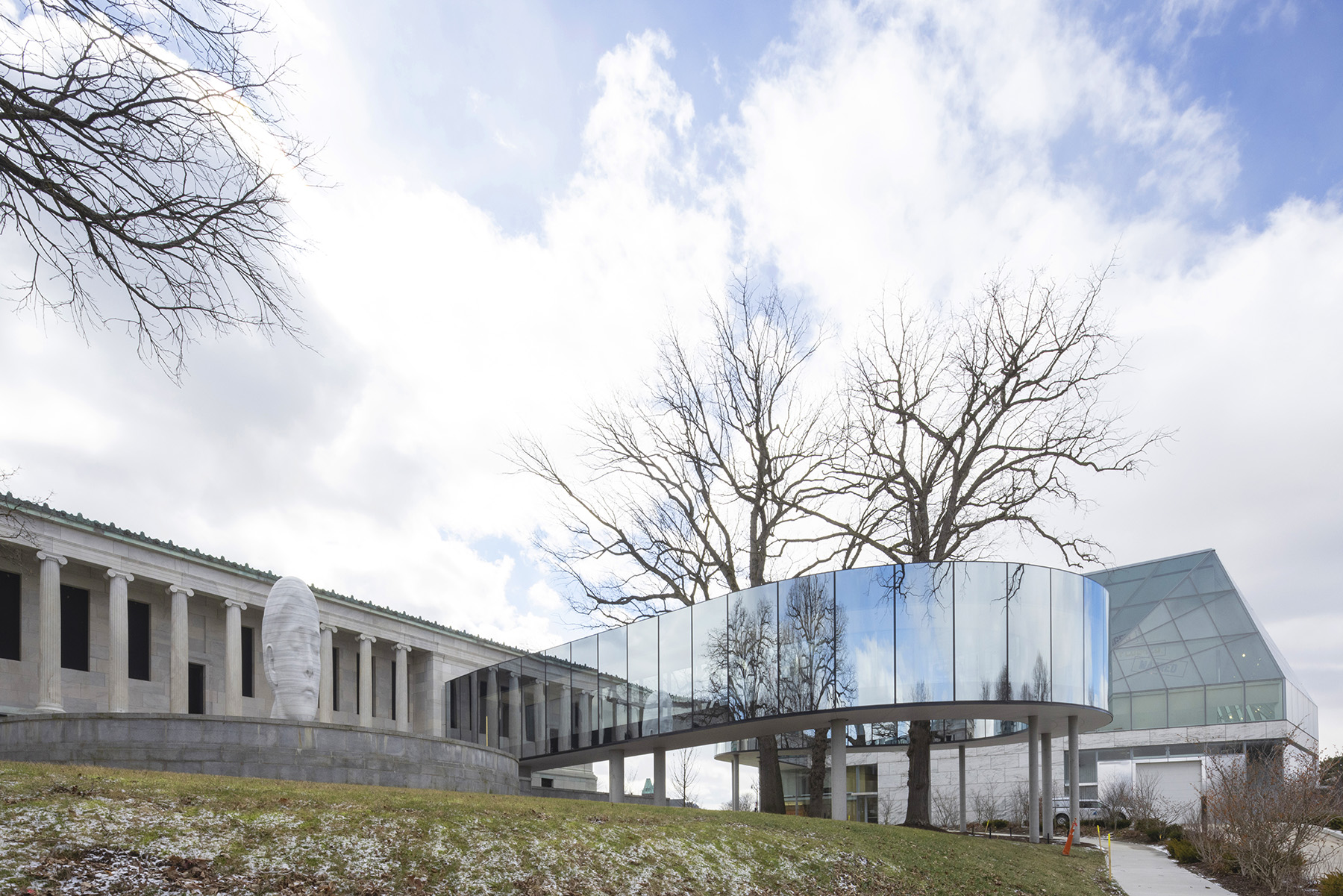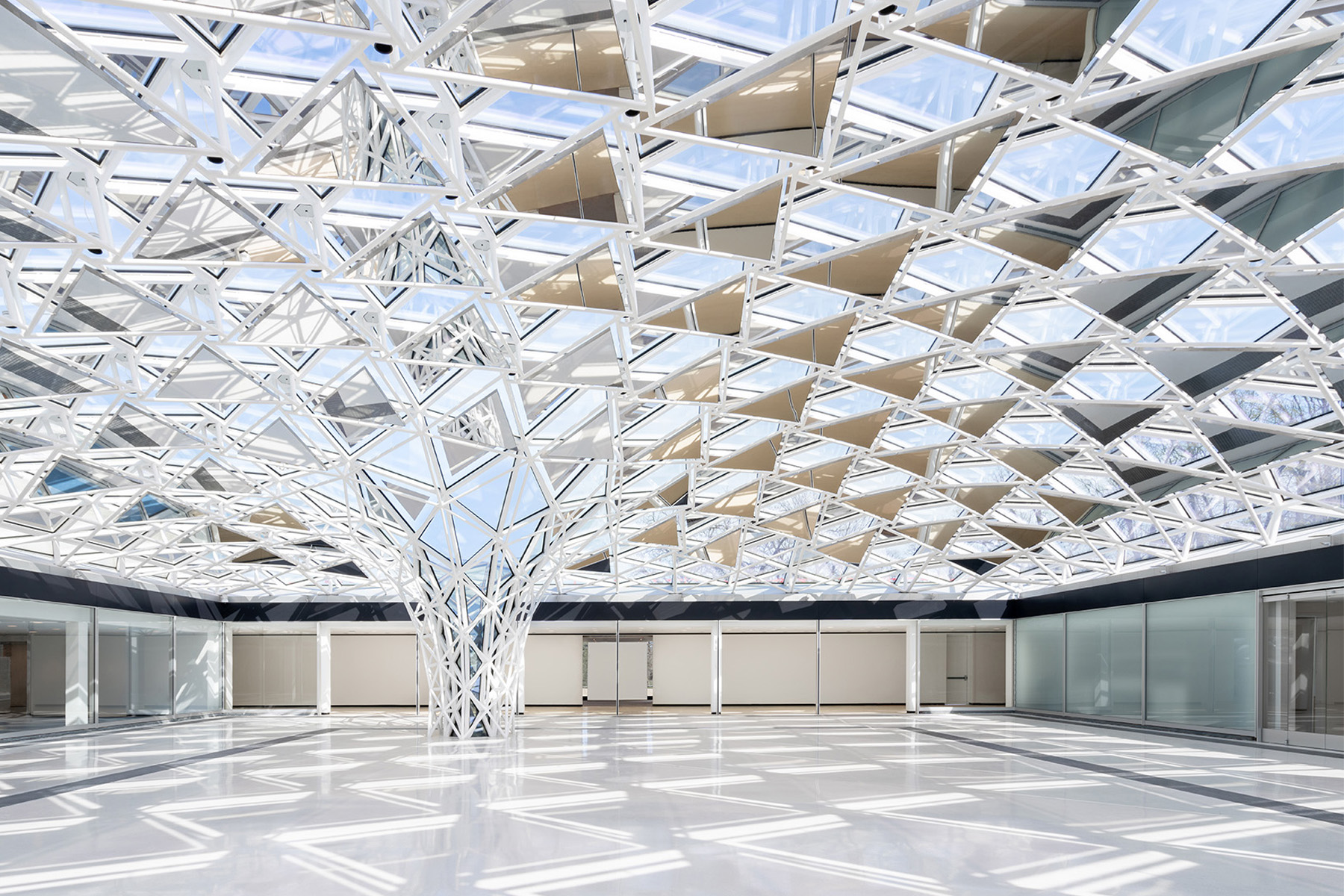
By Robert L. Reid
In Buffalo, New York, an art museum increased in size and in the scope of amenities offered. From an expansive new green space to a new indoor area that is itself a work of art, the facility’s old and new features have created another downtown landmark.
New art galleries, classrooms, and green spaces, brand-new connections between buildings, newly renovated structures, and even a name change are all hallmarks of the $230 million project that created the Buffalo AKG Art Museum in downtown Buffalo, New York.
Previously known as the Albright-Knox Art Gallery, the architecturally eclectic cultural campus is located within Buffalo’s Delaware Park and originally featured two main buildings, a Greek revival structure from 1905 named the Albright Art Gallery, and a Modernist addition built in 1962 with donations from Seymour H. Knox Jr. The most recent expansion was completed in 2023 and featured the construction of a 91,000 sq ft Contemporary-style building that adds more than 30,000 sq ft of gallery space to the museum complex.
This structure is known as the Jeffrey E. Gundlach Building after a major donor (hence the letters AKG — Albright, Knox, and Gundlach).
The project also includes the construction of an enclosed, elevated bridge to connect the Gundlach Building to the 1905 structure; it enclosed an open courtyard between the 1905 and 1962 buildings; and it constructed an underground parking garage beneath what had been a surface parking lot, now topped by more than half an acre of public parkland known as the Great Lawn.
Team effort
OMA was the design architect on the expansion and redevelopment project, and Cooper Robertson was the executive architect. Built environment consulting firm Arup provided structural engineering and lighting services for the Gundlach building, the elevated bridge, and the underground parking garage; the firm also performed structural renovation and modification work in the 1905 and 1962 buildings.
Thornton Tomasetti served as the facade engineering consultant to Cooper Robertson and was also responsible for waterproofing on the Gundlach Building and the new bridge, including the bridge roof. The firm was also responsible for the structural engineering of the new courtyard enclosure, which features an undulating canopy of glass and mirrors. Additionally, Thornton Tomasetti’s historic preservation team conducted renovation and restoration work on the 1905 and 1962 buildings.
Wendel was the project’s civil engineer and was responsible for the various zoning and environmental approvals, including coordination with various consultants on traffic, archaeological, and historical preservation studies. McMahon & Mann Consulting Engineering and Geology, P.C., was the geotechnical engineer, and Buro Happold was the mechanical, electrical, and plumbing engineer.
Michael Van Valkenburgh Associates was the landscape architect through design development; Wendel then implemented the Van Valkenburgh design through the construction documents and construction phases. Gilbane Building Co. was the project’s construction manager, and Beauce Atlas was the steel fabricator.
Amazing glazing
The Gundlach Building is a steel- and concrete-framed structure that, unusually for an art museum facility, is heavily glazed. “Most art museum buildings are not very transparent,” says Matt Jackson, P.E., S.E., an associate principal at Arup. “People don’t like too many windows” in art museums because “they bring in too much light that you can’t control,” Jackson explains.
But while the interior of the building features enclosed galleries for paintings, photographs, and other works of art that require tightly controlled light conditions, the perimeter of the structure is encased in a mostly glazed facade, dubbed “the Veil.” This creates an atrium space for artwork such as sculptures that are not as sensitive to light. “It also makes the building appear very transparent, especially at night when it’s lit from within,” Jackson says.

The faceted glass panels of the Veil are supported on a steel diagrid of structural mullions with stainless steel toggles to hold the panels in place, says Silverio Patrizi, a Thornton Tomasetti principal. Although an early proposal for the facade would have used curved glass, that approach would have been difficult and expensive, involving either hot or cold bending of the glass, says Patrizi. Instead, the segmented panels system simulates a gentle curve while saving costs and making installation simpler.
The sloped sections of the Veil feature a custom digital frit that — together with interior shading and the building’s mechanical systems — “will help control solar heat gains and ensure human thermal comfort,” according to project information on Thornton Tomasetti’s website. Because of Buffalo’s often harsh winters, extensive studies were also conducted to ensure that the Veil’s geometry could accommodate the risks of snow and ice.
The Gundlach facade also features a two-story marble entrance portal. OMA wanted to establish a connection between the new building and the old, so it incorporated marble elements, says Patrizi. The architects even traveled to Vermont to personally select each slab. Structurally, however, there is a critical difference between the stonework on the two buildings. Marble is quite sensitive to cold climates, Patrizi notes, and the 1 in. thick panels on the 1905 building eventually began to distort and deteriorate. To avoid that issue with the Gundlach, the marble sections are 4 in. thick, Patrizi says.
Inside, the building features large openings in its floors for a curving staircase “that had to be threaded through the structure with no apparent means of support,” says Jackson. The effect was achieved by constructing the stairs out of steel boxed sections that are torsionally stiff. This allows them to resist the forces that try to make the system untwist or deform as it curves around the corners, but they are carefully tied into the overall structure. “There’s quite a bit of steel hidden in there,” Jackson notes.
Underground issues
The Gundlach Building’s proximity to the nearby Scajaquada Creek meant that groundwater had the potential to create challenges during the excavation of the new facility’s roughly 30 ft deep basement. When that excavation work disturbed a confining layer of clay, which had essentially been holding back the groundwater, “we started to see seepages,” says Thomas A. Reynolds, P.E., M.ASCE, formerly a senior civil engineer at Wendel; Reynolds is now at Buffalo-based Nussbaumer & Clarke Inc.
The groundwater solution — developed by Wendel and McMahon & Mann — is composed of a dewatering system and a geomembrane, as well as an underdrain system for water and potential off-gasses, all of which were installed beneath the Gundlach Building’s 3 ft thick concrete slab foundation. The team also installed an artificial sump and a pump station “to mitigate any minor seepage that might make it through the geomembrane system,” notes Reynolds.

The new underground parking garage required an excavation about 18 ft deep and thus did not experience similar groundwater issues, adds Joseph A. Corio, P.E., M.ASCE, a Wendel civil engineer.
Another key civil engineering challenge involved the presence of an existing municipal sewer line that crossed the site. In addition to creating conflicts with the planned underground work for the museum expansion, especially beneath the soon-to-be-enclosed courtyard, the existing sewer line, made from clay tile, was also more than a century old and in poor condition, says Reynolds.
Wendel worked with the Buffalo Sewer Authority, the Department of Public Works, Parks & Streets, Buro Happold, and others to consider various options. After several alternative solutions were presented and assessed, the conflicting portion of old line was ultimately abandoned in place and filled with concrete, and a polyvinyl chloride pipe within a steel casing was installed on a new alignment using the jack and bore method, says Reynolds.
First, the team dug a roughly 20 ft deep excavation on the east side of the courtyard (that would ultimately contain the canopy), and then an auger boring machine drilled through the soil to install the roughly 160 ft long, 48 in. diameter steel casing, notes Corio. Stiff clays complicated this effort, and the work had to contend with tight horizontal and vertical tolerances, especially from the existing footings for the museum’s earlier buildings as well as the micropiles for the new enclosure over the courtyard.
“We were trying to fit this casing pipe through a small gap in between” those obstacles, Corio says, an effort that he concedes was “a little nerve-racking!”
Once the casing was installed, a 21 in. diameter PVC sewer pipe was threaded through the casing. Spacers on the PVC pipe and a blown-in peat gravel backfill ensured that the new line would not move around within the casing, says Corio. Thanks to the relatively shallow depth of the sewer line, this work also did not have to contend with groundwater issues, he adds.
Bridging buildings
The elevated bridge between the Gundlach Building and the 1905 building was originally intended to be on a straight alignment. Instead, it ended up as a serpentine structure in plan to avoid a grove of trees that needed to be preserved, says Jackson. “There were only a limited number of trees” on the site that could be removed, Jackson explains, but that proved to be a benefit rather than an obstruction.
“The trees that affected the bridge actually helped us,” he explains, “because they forced us to make the bridge longer, which meant we could change the slope, change the elevation between the two buildings.” The gentler slope that resulted made it easier to meet disability access requirements and also made it easier for museum staff to move potentially large artwork between the two buildings.

Although a steel bridge had also been considered, the final design is a flat-slab concrete structure that is supported on a series of concrete columns, circular in plan, that vary in size and location “to create a randomness that looks a bit like trees,” Jackson says.
The columns differ for aesthetic and structural reasons, Jackson explains, “with some taking more load than others and so needing to be larger.” Some are spaced closer together, others farther apart, to avoid the roots of the protected trees. Nineteen inches thick, the bridge slab is designed to act like a beam in torsion to resist the forces that want to make the structure twist as it turns corners, Jackson adds.
The bridge uses a glazing system similar to the Veil, with structural mullions and toggle supports, says Patrizi. Because the bridge slopes downward slightly toward the 1905 building, its roof acts “like a big canal, catching water and running it toward the historic building,” says Charles Van Winckle, a Thornton Tomasetti vice president. To protect the 1905 building, the bridge features drains and an overflow scupper system to divert water in case the primary drains become clogged, Van Winckle explains.
Uncommon covering
The courtyard between the 1905 and 1962 buildings was originally surrounded by a colonnade structure that was open to the elements, which in Buffalo meant it was not usable during the region’s often intense winters. To create a year-round space, the courtyard — now dubbed the Town Square — was covered with a glazed and mirrored canopy system that is also a work of art. Called Common Sky, the curving installation was designed by Berlin-based Studio Other Spaces.

Thornton Tomasetti, in collaboration with Germany-based ArtEngineering GmbH, engineered the canopy’s structural system. Measuring roughly 94 ft square and rising 23 ft tall, it rests on the courtyard’s preexisting columns and new shear walls. The design features a double-layered, curved shell roof composed of hollow steel sections — the outer layer uses square and rectangular sections to support the cladding’s glass panels, while the inner layer is made from circular hollow sections that support the suspended triangular mirror panels, according to Efe Karanci, Ph.D., P.E., a Thornton Tomasetti associate principal.
A perimeter ring truss supports the canopy structure and follows the outline of the courtyard, resisting horizontal thrust forces. Spherical slide bearings atop the existing courtyard columns support the truss’s inner chord.

A signature feature of the canopy is a funnel-shaped column offset toward the northeast side of the courtyard. Supported on a new piled footing, the funnel is the only part of the canopy that reaches the ground, marking “the spot where (a) lone tree, planted in the sixties, stood, providing a memorial to what came before,” according to Thornton Tomasetti’s website. The hollow “trunk” of the funnel allows “nature to extend into the courtyard ... where rain can fall and snow can collect in the winter.”

That hollow feature required a heat-tracing system to melt the snow that collects in the funnel and a drain at the base of the structure, says Karanci. The firm also carefully studied how the potential snow and wind loads might affect the canopy’s complicated geometry — work that was rewarded shortly after the canopy was installed in late 2022 when Buffalo experienced a four-day blizzard, and “everything worked fine,” Karanci recalls.
Green and renovated
The 60,000 sq ft underground parking garage is a conventional reinforced-concrete structure accessed via ramp from the loop driveway on the west side of the 1905 building. Sitting atop the garage is the new Great Lawn, which measures roughly 200 ft in the north-south direction and 180 ft in the east-west direction, says Corio. The lawn features roughly 12 in. to 18 in. of topsoil with an underlying sandy layer — akin to a high-performance golf green, says Reynolds. The new green space enhances the site’s sustainability by reducing impervious materials while also providing a venue for public events, according to the Wendel website.

A series of perforated perimeter drains flank the east and west walls of the parking garage, near the top of the structure, to transfer rainwater quickly through the underlying sandy soil mix and then out to the existing stormwater system. Wendel also designed a stormwater detention system, installed under the loop, that features a series of high-density polyethylene circular storage pipes designed to mitigate the peak discharge in accordance with the requirements of the Buffalo Sewer Authority.
The museum project also featured considerable renovations to the existing buildings, including the restoration of a set of stone stairs outside the 1905 building that had been removed during the 1962 expansion. The stairs connect the historical building to the Great Lawn. A new elevator was also installed inside the 1905 building, notes Jackson, and the marble topping above the hollow clay tile structural flooring system in the building was replaced with wood because the marble had failed over time.
Thornton Tomasetti performed extensive forensic studies, materials testing, and other analyses of the 1905 building’s marble cornice, which was “rotating off the building in areas,” as well as an ornamental band of marble at the base of the building that was “walking off,” says Van Winckle. Both problems had resulted from freeze-thaw damage to the underlying bricks caused by leaking gutters and the fact that the bricks were not designed for severe weather.
Consequently, the engineers removed the cornice stonework, repaired the leaking gutters, and re-anchored the marble. Steel plates were also welded to the bearing ends of some of the roof’s steel girders, which had corroded, to restore their capacity, Van Winckle notes. This work was especially challenging because of the limited access available in an attic crawl space crowded with mechanical system equipment that had to be dismantled and then reassembled.
At the base of the 1905 building, only certain sections of the ornamental marble were removed to access the damaged bricks, which were replaced with new climate-resistant masonry. The marble sections were then reinstalled with new lateral anchors, Van Winckle says.

Thornton Tomasetti also designed a weatherproofing roof system for the 1905 building. This was challenging to install because it had to be attached to the various substrates — what Van Winckle describes as “a checkerboard pattern of different roofing materials” that had been used over time. Ultimately, though, a liquid-applied roofing system mimics the building’s original copper roof, he says.
In the 1962 building, workers installed a new roof slab with a skylight, among other work, and both historical buildings were carefully cleaned. A series of mockups helped to ensure that the historical materials on each building could safely be restored to their original appearance, notes Van Winckle.
With a mix of modern and not-so-modern facilities, indoor and outdoor spaces, and structural and aesthetic enhancements, the Buffalo AKG Art Museum serves as a landmark in the city’s historic downtown, providing the community with expanded cultural amenities and opportunities well into the future.
Robert L. Reid is the senior editor and features manager of Civil Engineering.
Project credits
Client
Buffalo AKG Art Museum, Buffalo, New York
Design architect
OMA, New York City
Executive architect
Cooper Robertson, New York City
Landscape architect
Michael Van Valkenburgh Associates, Cambridge, Massachusetts
Structural engineer, lighting services, and structural renovation and modification
Arup, New York City
Mechanical, electrical, and plumbing engineer
Buro Happold, Bath, England
Civil engineer
Wendel, Williamsville, New York
Structural and facade engineering, waterproofing
Thornton Tomasetti, New York City
Geotechnical engineer
McMahon & Mann Consulting Engineering and Geology, P.C., Buffalo, New York
General contractor
Gilbane Building Co., Providence, Rhode Island
Steel fabricator
Beauce Atlas, Sainte-Marie, Quebec, Canada
Town Square roof, Common Sky design
Studio Other Spaces, Berlin, Germany
Historic preservation
Thornton Tomasetti, New York City
Preservation Studios LLC, Buffalo, New York
Common Sky structural engineer
Thornton Tomasetti, New York City
ArtEngineering GmbH, Schorndorf, Germany
Facade engineer of record
Büro Ehring, New York City
Connector bridge signature steel-and-glass enclosures
Büro Ehring, New York City
This article first appeared in the November/December 2025 issue of Civil Engineering as “Artistic Expansion.”



